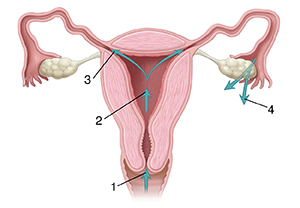A
B
C
D
E
F
G
H
I
J
K
L
M
N
O
P
Q
R
S
T
U
V
W
X
Y
Z
Click a letter to see a list of conditions beginning with that letter.
Click 'Topic Index' to return to the index for the current topic.
Click 'Library Index' to return to the listing of all topics.
What Is Pelvic Inflammatory Disease (PID)?
Pelvic inflammatory disease (PID) is an infection of the sex organs. It can cause severe damage to the body if not treated. PID sometimes causes symptoms bad enough to send you to the emergency room. But in many cases, PID is a silent infection. It can have few or no symptoms. The infection can be treated. This can help prevent lasting damage.
Who gets PID?
PID can happen at any age. But most women get it in their late teens or early 20s. Many don’t know they have PID until years later. The longer a woman is infected, the higher their risk of more health problems. The more sexual partners you have, the higher the risk. You are also more likely to get PID if you have had it before.
What are the symptoms?
If PID symptoms do happen, they are similar to those of many other health problems. This can make PID hard to find. Symptoms can include:
-
Pelvic pain
-
Pain during sex, or bleeding afterward
-
Painful peeing or peeing often
-
Fever, chills, or other flu-like symptoms
-
Discharge from the vagina that has a bad odor
-
Bleeding from the vagina that's not normal
-
Upset stomach and vomiting
-
Pain in the upper right belly
How did I get PID?

PID happens when certain germs infect the sex organs. Often this happens because you are infected with an STI (sexually transmitted infection). In a few cases, women develop PID while using an IUD (intrauterine device) for birth control. This often happens in the first 3 weeks after the IUD is put in place. PID is thought to happen in this way:
-
Semen is sent from the penis into the vagina during sex. Germs that cause an STI may enter with the semen.
-
Germs may go through the cervix and enter the uterus.
-
Germs travel from the uterus into the fallopian tubes and ovaries. These become infected.
-
The infection can leave the fallopian tubes and spread to other parts of the body.
Treatment can help
PID can often be cured when found and treated early. But PID can cause severe health problems if not treated. These include damage to the reproductive organs, pelvic pain, and problems getting pregnant (infertility). In rare cases, PID complications can even be life-threatening. This is why PID should be treated as soon as possible.
Online Medical Reviewer:
Donna Freeborn PhD CNM FNP
Online Medical Reviewer:
Heather M Trevino BSN RNC
Online Medical Reviewer:
Irina Burd MD PhD
Date Last Reviewed:
5/1/2022
© 2000-2025 The StayWell Company, LLC. All rights reserved. This information is not intended as a substitute for professional medical care. Always follow your healthcare professional's instructions.